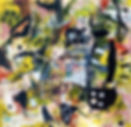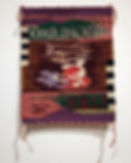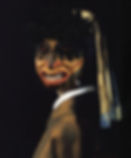“Exploding Native Inevitable”
by Lynn Trimble
SMoCA, Scottsdale, Arizona
Exhibition continues through January 5, 2025
October 5, 2024

Norman Akers, “Watchful Eye,” 2023, oil on canvas, 78 x 68”. Courtesy of the artist and Bates College Museum of Art, Lewiston, Maine.
Reflections on art, identity, symbolism, community, healing, and play take shape within “Exploding Native Inevitable,” featuring a dozen Indigenous artists and two artist collaboratives “from the land we now call America.” Collectively, these elder and emerging artists amplify the depth and breadth of contemporary Indigenous art, which encompasses a vast array of ideas, cultural knowledge, processes, and materials. Stereotyping is no longer an option.
The exhibition is physically and conceptually grounded by “Post” (2022-23) a painting installation with digital projections by Nebraska-based artist Sarah Rowe (Lakota, Ponca). With its accessible ramp and imagery blending “traditional indigenous iconography, personal forms, and popular culture,” Rowe’s treehouse-like structure beckons us into the gallery space, then into the installation itself. Inviting both solitude and communal experience, the piece fuels impulses toward curiosity and exploration, echoing elements of the show’s origin story and the inspiration for its title.
The imagery in “Post” echoes Rowe’s larger body of work, which often centers on Heyoka, a sacred clown of Lakota culture described as a contrarian who uses laughter to channel spiritual wisdom. The reference also aligns with the spirit of the exhibition itself. Even as exhibited works draw viewers into the expansive universe of contemporary Indigenous art, they also speak to historical and current manifestations of settler culture and colonization. Meanwhile, text panels with the artists’ own words affirm the primacy of Indigenous voices.

Nizhonniya Austin, “Forgiving the Future,” 2023, acrylic on canvas, 40 x 40”. Courtesy of the artist.
The exhibition is co-curated by Brad Kahlhamer, an Arizona- and New York-based visual artist and musician. Kahlhamer, whose own work often explores his identity as the child of Indigenous parents who was adopted in infancy by a German American family, maintains a nomadic creative practice that has led to substantive encounters with the artists featured here. Dan Mills, Director of the Bates College Museum of Art in Lewiston, Maine, where the show was debuted in 2023, shared curatorial duties.
The show is titled in homage to the “Exploding Plastic Inevitable,” Andy Warhol’s renowned 1966-1967 multimedia series with its intersections of art, film, music, and live performance. Hence, creative programming aligned with the exhibition is planned for each venue. There is in fact a deep connection at play between visual art and other creative disciplines, such that the reference to Warhol’s series establishes historical precedent for the multimedia approach the show and many of its artists take, especially with regard to music and language preservation.

Tyrell Tapaha, “Ashkii: The Boy Who Lives in Two Worlds,” 2021, handspun vegetal-dye Navajo churro, brown sheep, Navajo-raised alpaca. Courtesy of the artist and the Avaro D. Marquez collection.
In one case, bassist, singer, and composer Mali Obomsawin (Abenaki First Nation) and artist and community organizer Lokotah Sanborn (Penobscot), both based in Maine, collaborated on the video piece “Wawasintda” (2022). Other artists whose work spans multiple fields include Nizhonniya Austin (Diné/Tlingit), Elisa Harkins (Muscogee/Creek Nation), Sky Hopinka (Ho-Chunk Nation of Wisconsin/Pechanga Band of Luiseño Indians), and Fox Maxy (Mesa Grande Band of Mission Indians and Payómkawichum).
“Exploding Native Inevitable” also features drawings, paintings, sculpture, textiles, and prints, thereby countering the persistent stereotype of Native American art as confined to particular crafts such as woven baskets, ceramic vessels, or silver jewelry. Several of the most impactful pieces, including those by Washington-based artist and language advocate Alison Bremner (Tlingit), blend Indigenous iconography with imagery drawn from art history or popular culture. In two 2014 digital photographs, “‘Wat’sa with Pearl Earring” and “Mona Lisa Smile,” for example, Bremner employs subversive humor to call out cultural appropriators.

Alison Bremner, “Wat’sa with Pearl Earring,” 2014, digital photograph, 24 x 16″. Courtesy of the artist.
The exhibition foregrounds the prevalence of collaborative processes and public-facing interventions in contemporary Indigenous art, while also demonstrating the many cultural sources that Native artists draw from in their creative practices. Large-scale photographs documenting “murals of visual resistance” by New Mexico-based artist Jaque Fragua (Jemez Pueblo) reveal his skill at integrating Indigenous, punk, and graffiti aesthetics. “Never Settle: Calling In” (2020), a video by New Red Order — a collaborative whose core members include New York-based Adam Khalil (Ojibway), Zach Khalil (Ojibway), and Jackson Polys (Tlingit) — draws on corporate language and marketing techniques to engage us as “accomplices in promoting Indigenous futures.”
Additional “Exploding Native Inevitable” artists include Norman Akers (Osage Nation), Raven Halfmoon (Caddo Nation), Terran Last Gun (Piikani/Blackfeet), Duane Slick (Meskwaki/Sauk), and Tyrrell Tapaha (Diné). Collectively, these artists widen the lens through which contemporary Indigenous art is seen and understood, illuminating the broad range of ideas, materials, and processes they evince, as well as the Native cultural sources imbued in their work. They are contemporary no less than Indigenous.

